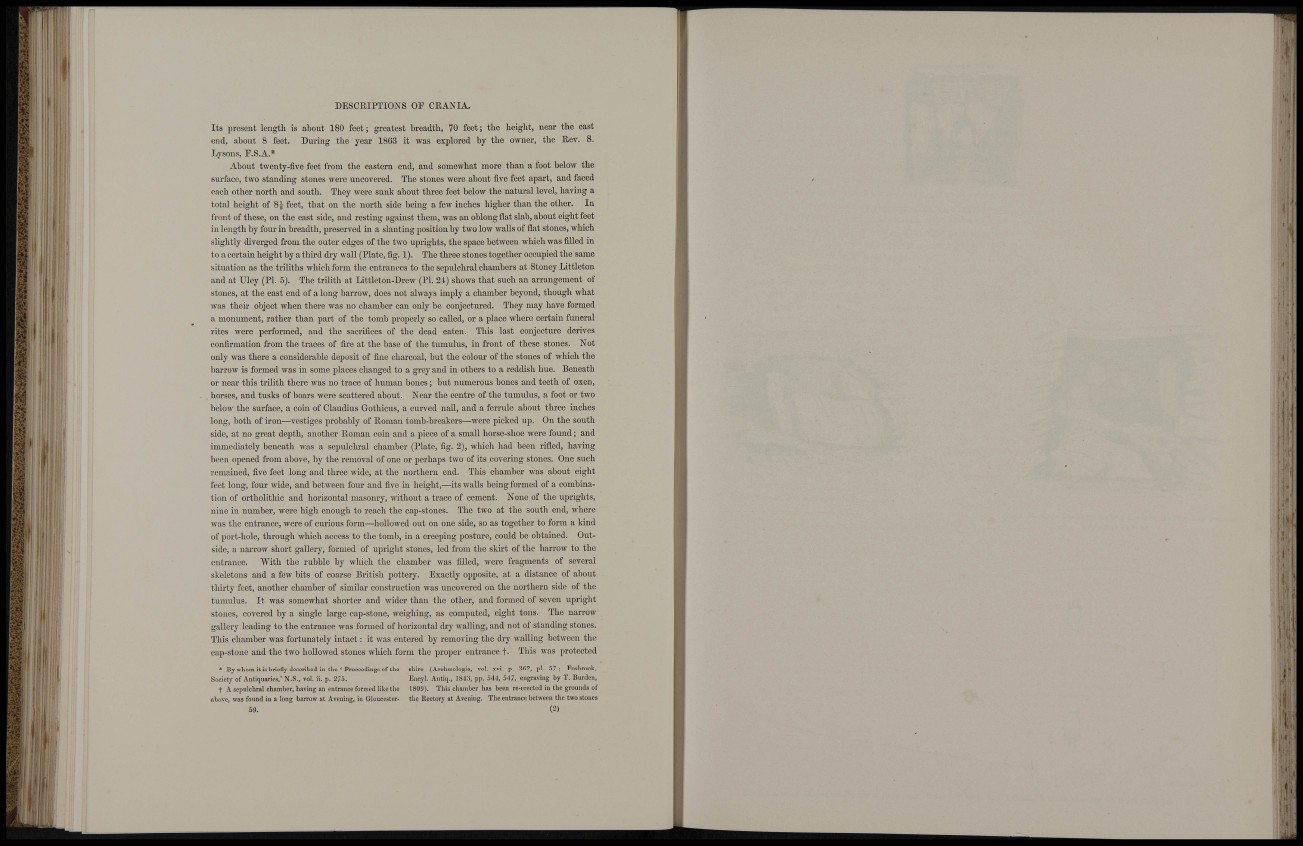
m
.•np;
ifiiiiiijir
DESCRIPTIONS 01? CRANIA.
Its present length is cabout 180 feet; greatest breadth, 70 feet; the height, near the east
end, about 8 feet. During the year 1863 it was explored by the owner, the Rev. S.
Lysons, P.S.A.*
About twenty-five feet from the eastern end, and somewhat more than a foot below the
surface, two standing stones were uncovered. The stones were about five feet apart, and faced
cach other north and south. They were sunk abou.t three feet below the natural level, having a
total height of SJ feet, that on the north side being a few inches higher than the other. In
front of these, on the east side, and resting against them, was an oblong flat slab, about eight feet
in length by four in breadth, preserved in a slanting position by two low walls of flat stones, which
•slightly diverged from the outer edges of the two uprights, the space between which was filled in
to a certain height by a thu'd dry ivall (Plate, fig. 1). The three stones together occupied the same
situation as the triliths which form the entrances to the sepulchral chambers at Stoney Littleton
and at Uley (PI. 5). The trilitb at Littleton-Drew (PI. 2^.) shows that such an arrangement of
stones, at the east end of a long barrow, does not always imply a chamber beyond, though what
was their object when there was no chamber can only be conjectured. They may have formed
a monument, rather than part of the tomb properly so called, or a place where certain funeral
rites were performed, and the sacrifices of the dead eaten. This last conjecture derives
confirmation from the traces of fire at the base of the tumulus, in front of these stones. Not
only was there a considerable deposit of fine charcoal, but the colour of the stones of which the
barrow is formed was in some places changed to a grey and in others to a reddish hue. Beneath
or near this trilitb there was no trace of human bones; but numerous bones and teeth of oxen,
horses, and tusks of boars were scattered about. Near the centre of the tumiilus, a foot or two
below the surface, a coin of Claudius Gothicus, a curved nail, and a ferrule about three inches
long, both of iron—vestiges probably of Roman tomb-breakers—were picked up. On the south
side, at no great depth, another Roman coin and a piece of a small horse-shoe were found; and
immediately beneath was a sepulchral chamber (Plate, fig. 2), which had been rifled, having
been opened from above, by the removal of one or perhaps two of its covering stones. One such
remained, five feet long and three wide, at the northern end. This chamber was about eight
feet long, four wide, and between four and five in height,—its walls being formed of a combination
of ortholithic and horizontal masonry, without a trace of cement. None of the uprights,
nine in number, were high enough to reach the cap-stones. The two at the south end, where
was the entrance, were of curious form—hoUowed out on one side, so as together to form a kind
of port-hole, through which access to the tomb, in a creeping posture, could be obtained. Outside,
a narrow short gallery, formed of upriglit stones, led from the skirt of the barrow to the
entrance. With the rubble by which the chamber was filled, were fragments of several
skeletons and a few bits of coarse British pottery. Exactly opposite, at a distance of about
thirty feet, another chamber of similar construction was uncovered on the northern side of the
tumiilus. It was somewhat shorter and wider than tlie other, and formed of seven upright
stones, covered by a single large cap-stone, weighing, as computed, eight tons. The narrow
gallery leading to the entrance was formed of horizontal dry walling, and not of standing stones.
This chamber was fortunately intact: it was entered by removing the dry walling between the
cap-stone and the two hollowed stones which form the proper entrance +. This was protected
* By whom it is briefly described in the ' Proceedings of the
Society of Antiquaries,' N.S., vol. ii. p. 27.0.
t A sepulchral chamber, having an entrance formed like the
above, was found in a long barrow at Avening, in Gloucester-
59.
shire (Archceologia, vol. xvi. p. 362, pi. 57 ; Fosbrook,
Encyl. Antiq., 1843, pp. 544, 547, engraving by T. Burden,
1809). This chamber has been re-erected in the grounds of
the Uectory at Avening. The entrance between the two stones
(2)
!• 'I
I-
' I, •
... I:'
l.l-
J1 'I
, - f
li-) •
I -lil'
'f